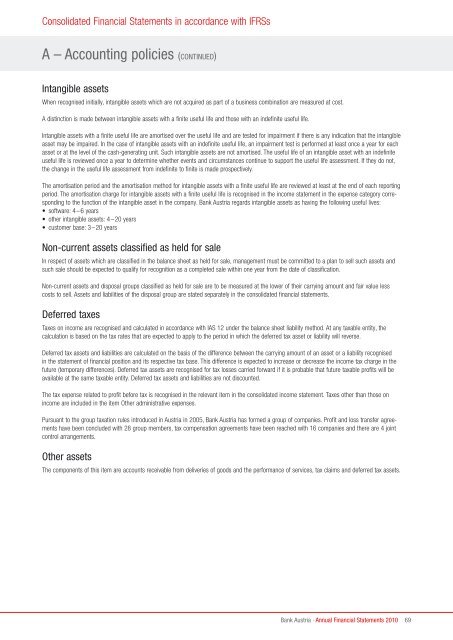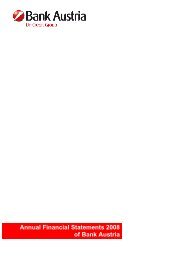Annual Financial Statements 2010 of Bank Austria
Annual Financial Statements 2010 of Bank Austria
Annual Financial Statements 2010 of Bank Austria
You also want an ePaper? Increase the reach of your titles
YUMPU automatically turns print PDFs into web optimized ePapers that Google loves.
Consolidated <strong>Financial</strong> <strong>Statements</strong> in accordance with IFRSs<br />
A – Accounting policies (CoNTINuED)<br />
Intangible assets<br />
When recognised initially, intangible assets which are not acquired as part <strong>of</strong> a business combination are measured at cost.<br />
A distinction is made between intangible assets with a finite useful life and those with an indefinite useful life.<br />
Intangible assets with a finite useful life are amortised over the useful life and are tested for impairment if there is any indication that the intangible<br />
asset may be impaired. In the case <strong>of</strong> intangible assets with an indefinite useful life, an impairment test is performed at least once a year for each<br />
asset or at the level <strong>of</strong> the cash-generating unit. Such intangible assets are not amortised. The useful life <strong>of</strong> an intangible asset with an indefinite<br />
useful life is reviewed once a year to determine whether events and circumstances continue to support the useful life assessment. If they do not,<br />
the change in the useful life assessment from indefinite to finite is made prospectively.<br />
The amortisation period and the amortisation method for intangible assets with a finite useful life are reviewed at least at the end <strong>of</strong> each reporting<br />
period. The amortisation charge for intangible assets with a finite useful life is recognised in the income statement in the expense category corresponding<br />
to the function <strong>of</strong> the intangible asset in the company. <strong>Bank</strong> <strong>Austria</strong> regards intangible assets as having the following useful lives:<br />
• s<strong>of</strong>tware: 4–6 years<br />
• other intangible assets: 4–20 years<br />
• customer base: 3–20 years<br />
Non-current assets classified as held for sale<br />
In respect <strong>of</strong> assets which are classified in the balance sheet as held for sale, management must be committed to a plan to sell such assets and<br />
such sale should be expected to qualify for recognition as a completed sale within one year from the date <strong>of</strong> classification.<br />
Non-current assets and disposal groups classified as held for sale are to be measured at the lower <strong>of</strong> their carrying amount and fair value less<br />
costs to sell. Assets and liabilities <strong>of</strong> the disposal group are stated separately in the consolidated financial statements.<br />
Deferred taxes<br />
Taxes on income are recognised and calculated in accordance with IAS 12 under the balance sheet liability method. At any taxable entity, the<br />
calculation is based on the tax rates that are expected to apply to the period in which the deferred tax asset or liability will reverse.<br />
Deferred tax assets and liabilities are calculated on the basis <strong>of</strong> the difference between the carrying amount <strong>of</strong> an asset or a liability recognised<br />
in the statement <strong>of</strong> financial position and its respective tax base. This difference is expected to increase or decrease the income tax charge in the<br />
future (temporary differences). Deferred tax assets are recognised for tax losses carried forward if it is probable that future taxable pr<strong>of</strong>its will be<br />
available at the same taxable entity. Deferred tax assets and liabilities are not discounted.<br />
The tax expense related to pr<strong>of</strong>it before tax is recognised in the relevant item in the consolidated income statement. Taxes other than those on<br />
income are included in the item Other administrative expenses.<br />
Pursuant to the group taxation rules introduced in <strong>Austria</strong> in 2005, <strong>Bank</strong> <strong>Austria</strong> has formed a group <strong>of</strong> companies. Pr<strong>of</strong>it and loss transfer agreements<br />
have been concluded with 28 group members, tax compensation agreements have been reached with 16 companies and there are 4 joint<br />
control arrangements.<br />
other assets<br />
The components <strong>of</strong> this item are accounts receivable from deliveries <strong>of</strong> goods and the performance <strong>of</strong> services, tax claims and deferred tax assets.<br />
<strong>Bank</strong> <strong>Austria</strong> · <strong>Annual</strong> <strong>Financial</strong> <strong>Statements</strong> <strong>2010</strong><br />
69
















